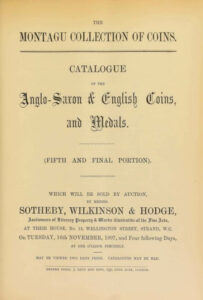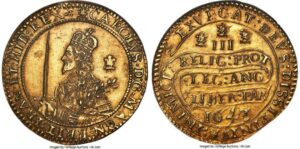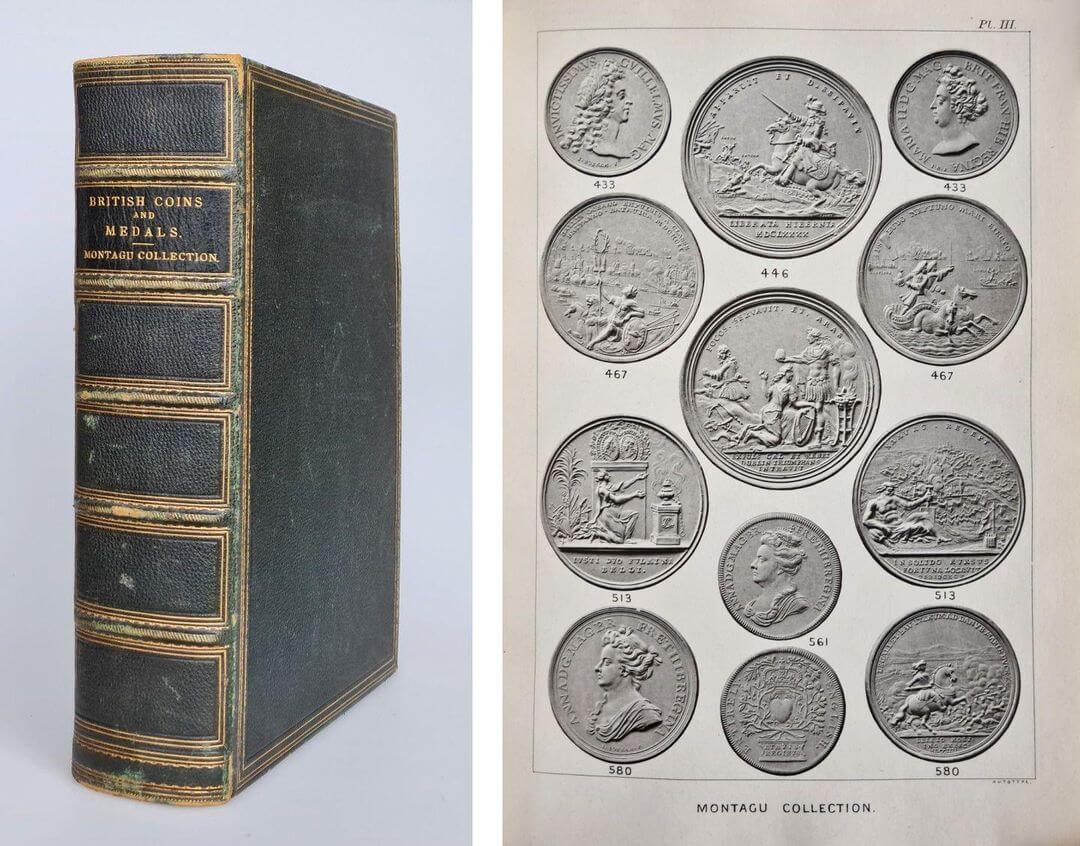Montagu, Hyman (1844-1895)
by Hadrien Rambach
Born Hyman Moses, Montagu was a London solicitor who established himself as an expert in bankruptcy. His first collecting interest was in entomology (beetles), but he turned towards coins and medals in 1878. He specialized in English hammered and milled coins, buying the entire collections of Samuel Addington (1883) and William Brice (1887), writing numerous articles and a book on The Copper, Tin and Bronze Coinage and Patterns for Coins of England (published in 1885 with a second edition in 1893).

Front page of the Sotheby catalogue for the fifth and final part of the Montagu collection of English coins, 1897.
After starting to also collect Roman coins, he bid heavily in Ponton d’Amécourt’s auction in 1887, and then bought his first Greek coin in 1889. He acquired the entire inventory of the Parisian dealer Hoffmann when he retired in 1893, was in direct contact with most European dealers, and travelled extensively. He himself published a selection of his Greek coins, and then – postumously – of his Roman coins. His Roman gold coins were auctioned by Rollin & Feuardent in April 1896, for a total of 363,004 francs. Interestingly, the copy of the sale catalogue preserved at the Fitzwilliam Museum (from the 1912 Marlay bequest) indicates the selling prices but often preceeds them with the words “withdrawn at” which suggests that the sale was not as successful as it seems (for example the lots 4, 7-9, 11-12, 13 etc). His collection of 1291 Roman gold coins remained the largest ever built until that of Biaggi, and its quality was on average much higher.

Great Britain. Charles I. Gold Triple Unite 1643. Ex Montagu Collection. From Heritage Auctions Auction 3094 (2021), 33192.
He died in his fiftieth year, and – like Quelen and Durkee – he too might have continued collecting to unprecented levels if not for his premature death. His importance can be underscored by the fact that it was on his invitation (!) that William Webster joined Spink in 1892. In fact, Forrer estimated that the sale through Spink of the Greek and English coins had brought over £55,000 (1,400,000 francs). The Roman gold coins were just a fraction of his extensive collection, and the Greek coins, British coins and medals required numerous auctions in London to disperse. “His very large collection seems to have been in a constant flux during his lifetime, during which various sales of duplicates took place, but its final composition is well recorded in the catalogues of eight sales held by Sotheby between 1895 and 1897”.
Bibliography:
- J. Eaglen, P. D. Mitchell and H. E. Pagan, “Coin tickets in the British Hammered Series”, in British Numismatic Journal, 2001, p. 149.
- Leonard Forrer, “Numismatic reminiscences of the last sixty years”, in British Numismatic Journal, vol. 73 (2003), pp. 191-196: pp. 193 and 194.
- Harrington Manville, Biographical dictionary of British and Irish numismatics, London 2009, pp. 188-189.
- John Spring, Ancient Coins Auction Catalogues 1880-1980, London 2009, p. 296.
- Hyman Montagu, “On some unpublished and rare Greek coins in my collection”, in The Numismatic Chronicle and Journal of the Numismatic Society, vol. 3-XII (1892), pp. 22-39; “Rare and Unpublished Roman Gold Coins in my Collection”, in The Numismatic Chronicle and Journal of the Numismatic Society, vol. 3-XVII (1897), pp. 35-89; Jerome J. Platt and Arleen Kay Platt, British Historical Medals of the 17th Century. Medallists, books, authors, collectors, book-sellers & antiquaries, London 20147, pp. 312-317.
- Hadrien Rambach, “Provenance glossary”, in Numismatica Ars Classica, Auction 91: the George W. La Borde collection of Roman aurei – part I, Zurich, 23 May 2016, pp. [67]-[79].
- Hadrien Rambach, “Provenance glossary”, in Numismatica Ars Classica, Auction 99: the George W. La Borde collection of Roman aurei – part II, Zurich, 29 May 2017, pp. 47-63.
- Hadrien Rambach, “Provenance glossary”, in Numismatica Ars Classica, Auction 105: the George W. La Borde collection of Roman aurei – part III, Zurich, 9 May 2018, pp. 82-105.
This article was first published in a catalogue of auction house Numismatica Ars Classica.








